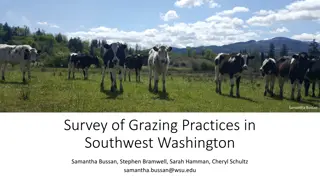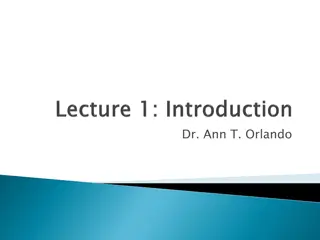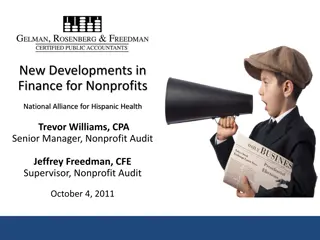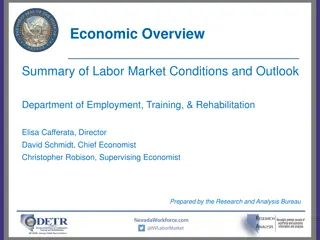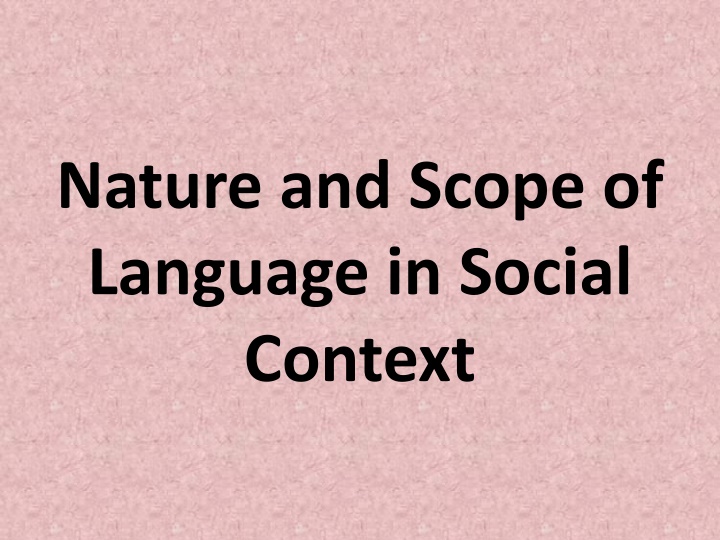
Understanding Sociolinguistics and Its Social Context
Sociolinguistics delves into the intricate relationship between language and society, exploring how language shapes social interactions and groups. This comprehensive study challenges assumptions about the nature of language and highlights the social nature of linguistic interactions. Through a socially realistic approach, sociolinguists unravel the dynamics of language usage within communities, emphasizing the inherent sociality of human communication.
Download Presentation

Please find below an Image/Link to download the presentation.
The content on the website is provided AS IS for your information and personal use only. It may not be sold, licensed, or shared on other websites without obtaining consent from the author. If you encounter any issues during the download, it is possible that the publisher has removed the file from their server.
You are allowed to download the files provided on this website for personal or commercial use, subject to the condition that they are used lawfully. All files are the property of their respective owners.
The content on the website is provided AS IS for your information and personal use only. It may not be sold, licensed, or shared on other websites without obtaining consent from the author.
E N D
Presentation Transcript
Nature and Scope of Language in Social Context
Morphology of the word sociolinguistics What does it indicate? Or What do people expect when they read it or hear it?
The 'shape' or morphology of the word 'sociolinguistics' sets up an expectation that sociolinguistics is a version of, or a way of doing, linguistics. It seems to be that part of linguistics which attends to 'social questions. Do you agree with this? Are these assumptions accurate?
Several writers have pointed to the inaccurate assumptions behind this interpretation. Labov writes that he resisted the term sociolinguistics because it implies, mistakenly, that there can be a sort of linguistics that is not social.
He inquires: What is language if not a means of establishing contact between people? So isn't language an inherently social process? Doesn't language define the sociality of human beings? Sociolinguists of all persuasions would of course agree that this is the case. Do you agree with Labov?
To answer the questions that Labov has set for himself, there is no alternative to studying actual uses of language in its natural contexts. Only a 'socially realistic' approach will reveal patterns in the distribution of language forms within communities and over time. Certain truths about language can only emerge from analyses based on real language data.
What is sociolinguistics?
Defining sociolinguistics has never been without its controversies. Sociolinguistics is probably the most active but also the most diverse area of contemporary language studies.
It is the science that studies the relationship between language and society. Or it is the study of language in its social contexts and the study of social life through linguistics.
What are the main concerns of Sociolinguistics?
1. How are forms of speech and patterns of communication distributed across time and space? 2. How do individuals and social groups define themselves in and through language? 3. How do communities differ in the 'ways of speaking' they have adopted? 4. What are the typical patterns in multilingual people's use of languages? 5. How is language involved in social conflicts and tensions? 6. Do our attitudes to language reflect and perpetuate social divisions and discrimination, and could a better understanding of language in society alleviate these problems?
Sociolinguistics VS Sociology Sociolinguistics is concerned with investigating the relationships between language and society with the goal of getting a better understanding of the structure of language and of how languages function in communication
Sociolinguistics VS Sociology sociology is trying to discover how social structure can be better understood through the study of language
Sociolinguistics VS Sociology Hudson (1996, 4) has described the difference as follows: sociolinguistics is the study of language in relation to society, whereas the sociology of language is the study of society in relation to language.
Sociolinguistics VS Sociology In other words, in sociolinguistics we study language and society in order to find out as much as we can about what kind of thing language is, and in the sociology of language we reverse the direction of our interest.
Sociolinguistics VS Sociology Coulmas (1997, 2) says that sociolinguistics investigates how social structure influences the way people talk and how language varieties and patterns of use correlate with social attributes such as class, sex, and age.
Sociolinguistics VS Sociology Sociology studies what societies do with their languages, that is, attitudes and attachments that account for the functional distribution of speech forms in society, language shift, maintenance, and replacement, the delimitation and interaction of speech communities
Sociolinguistics studies the relationship between language and society. It is interested in:
1. Explaining why we speak differently in different social contexts 2. Identifying the social functions of language and the ways it is used to convey social meaning
Why is it important to examine the way people use language in different social contexts?
Examining the way people use language in different social contexts provides a wealth of information about the way language works, as well as about the social relationships in a community, and the way people convey and construct aspects of their social identity through their language
Language serves a range of functions; to ask for and give people information, to express indignation and annoyance, as well as admiration and express feelings.
EXAMPLE 1 Ray : Hi mum. Mum: Hi. You re late. Ray : Yeah, that bastard Sootbucket kept us in again. Mum: Nana s here. Ray : Oh sorry. Where is she?
Had Ray realized that his grandmother could hear him, he would have described his teacher differently, don t you think so?
The way people talk is influenced by the social context in which they are talking. It matters who can hear us and where we are talking, as well as how we are feeling. The same message may be expressed very differently to different people. We use different styles in different social contexts
EXAMPLE 2 Ray Principal : What are you doing here at this time? Ray : Mr. Sutton kept us in, sir. : Good afternoon, sir. What does Ray s response indicate?
This response indicates Rays awareness of the social factors which influence the choice of appropriate ways of speaking in different social contexts
Analysis Ray s utterance: Yeah, that bastard Sootbucket kept us in again. not only tells his mother why he is late, his choice of words also tells her how he feels about the teacher, and tells us something about his relationship with his mother (he can use words like bastard talking to her) compared to his grandmother and the principal (to whom he uses sir ). The way Ray expresses himself indicates that his relationship with his mother is an intimate and friendly one, rather than a formal, distant or respectful one.
Languages provide a variety of ways of saying the same thing addressing and greeting others, describing things, paying compliments: Why do we say the same thing in different ways?
The choice of one linguistic form rather than another is a useful clue to nonlinguistic information. Our choices provide clues to social factors, such as the relationship between the people in the particular situation, and how the speaker feels about the person addressed. Thus, linguistic variation can provide social information.
Example 3 Every afternoon my friend packs her bag and leaves her Cardiff office in southern Wales at about 5 o clock. As she leaves, her business partner says goodbye Margaret (she replies goodbye Mike), her secretary says see you tomorrow (she replies bye Jill ), and the caretaker says bye Mrs Walker (to which she responds goodbye Andy ). As she arrives home she is greeted by hi mum from her daughter, Jenny, hello dear, have a good day? from her mother, and simply you re late again ! from her husband. Later in the evening the president of the local flower club calls to ask if she would like to join the club. Good evening, is that Mrs Billington? she asks. No, it s Margaret Walker, but my husband s name is David Billington , Margaret answers. What can I do for you? Finally a friend calls Hello Meg, sut dach ti?
Example 4 Sam : You seen our enry s new ouse yet? It s in alton you know. Jim : I have indeed. I could hardly miss it Sam. Your Henry now owns the biggest house in Halton.



